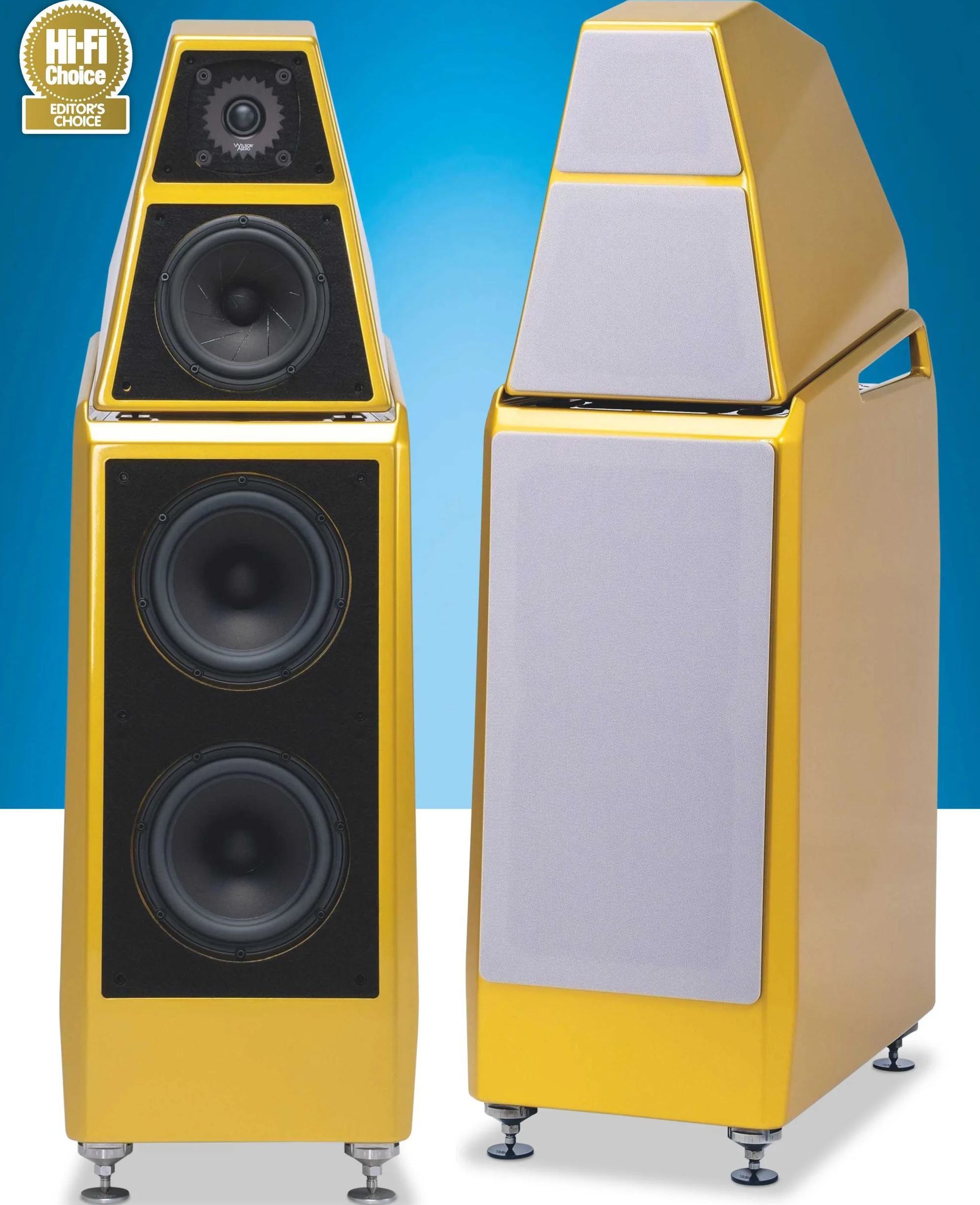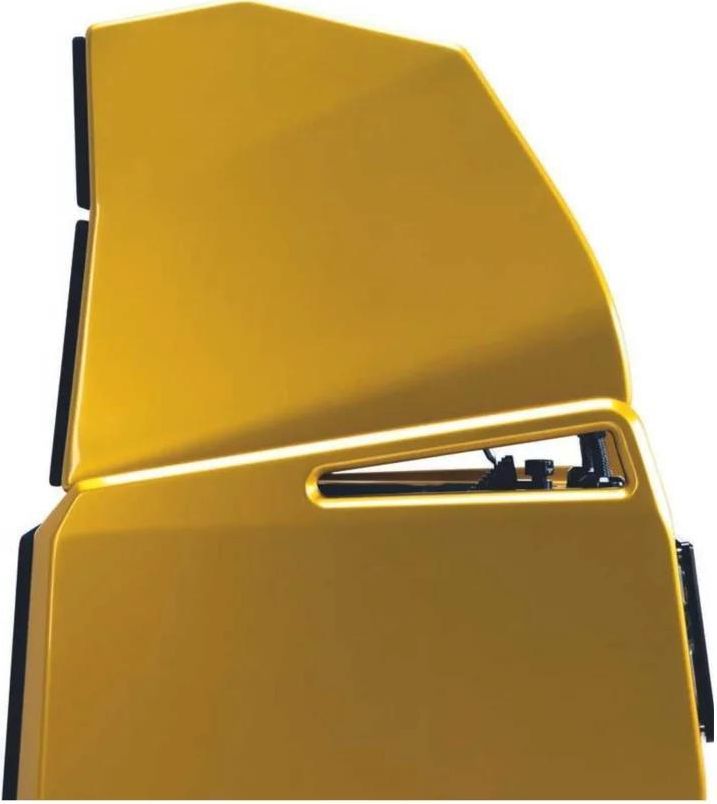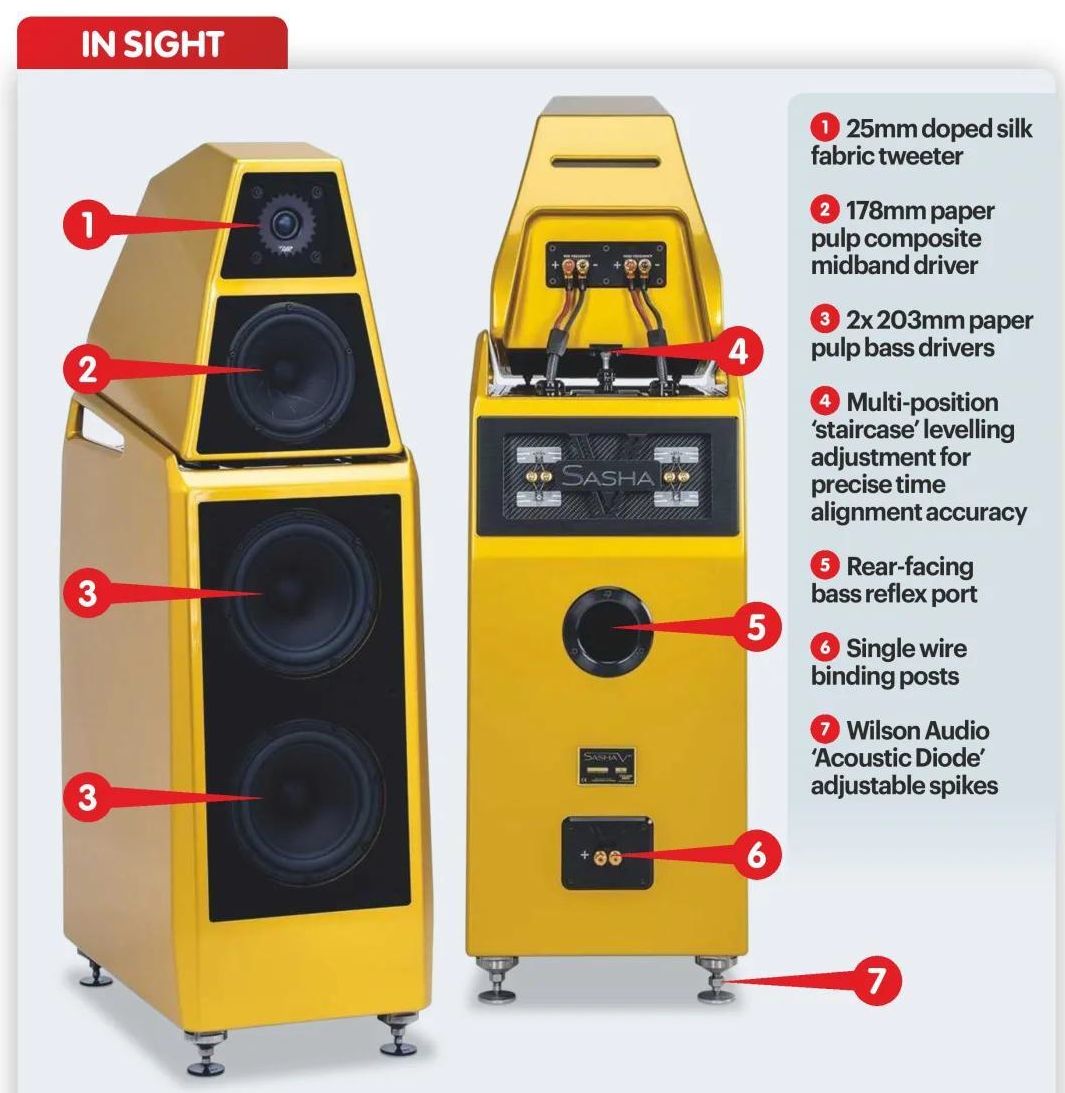Wilson Audio Sasha V Review: Simply superlative
“Naturally, this is an excursion into the vast land of boundless irrationality. But I can rightfully say that I have rarely been as excited about a speaker as I am about this one.”

Specs
| PRODUCT | Wilson Audio Sasha V |
| ORIGIN | USA |
| TYPE | Floorstanding loudspeaker |
| WEIGHT | 111kg |
| DIMENSIONS (WxHxD) | 368 x 1,145 x 608mm |
| FEATURES | 25mm doped silk fabric tweeter 178mm paper pulp composite midband driver 2x 203mm paper pulp bass drivers Quoted sensitivity: 88dB/1W/1m(4ohm) |
| DISTRIBUTOR | Absolute Sounds Ltd |
| WEBSITE | wilsonaudio.com absolutesounds.com |
Historical Background
I probably don’t need to explain who Wilson Audio is. This cult loudspeaker manufacturer is based in a seemingly unlikely region of the USA, the Mormon state of Utah. For almost 50 years, David A. Wilson and his team have relentlessly pursued sonic truth, a quest that the market continues to honor like few other speaker manufacturers. At this year’s High End in Munich, there were numerous exhibitors showcasing speakers from Provo. It is impossible to discuss Wilson Audio without mentioning the “WATT/Puppy” model. Few designs have achieved such renown over the years as this two-part system, consisting of the pyramid-shaped compact speaker “Wilson Audio Tiny Tot” and the bass supplement “Puppy.” Originally conceived as a compact studio monitor, this setup, especially after the addition of the bass module, found its way into audiophiles’ living rooms worldwide.
The Sasha V
Over the years, the Watt/Puppy has undergone many developments, and eventually, even the name changed. The cumbersome double designation was replaced by the sleeker “Sasha,” now in its latest version “V” in our listening room. In this case, “V” does not stand for the Roman numeral five but for the composite material “V” that Wilson Audio uses strategically in the cabinet of this speaker generation, a feature borrowed from larger models now incorporated into the Sasha V. Wilson speakers are not budget-friendly, and the Sasha V is no exception: the base model costs 59,000 euros per pair, and with special paint, as in this case, it goes up to 65,000 euros.
Mechanics
A crucial aspect of Wilson speakers is the adjustable phase alignment between the individual drivers. While the top models allow nearly every driver to be individually shifted and tilted, the Sasha V focuses on making the mid-high section adjustable relative to the bass cabinet. In the latest generation, this means that the inclination of the upper cabinet is multi-stage variable, and the upper body can also be adjusted in depth in two ways. This allows fine-tuning of the phase alignment and the sound emission directions of the individual drivers. The gentle bend in the baffle between the midrange and tweeter also aids in aligning their sound emissions.

The cabinet shape of the new Sasha V has changed very little from the predecessor model “Sasha DAW.” However, company head Daryl Wilson, a designer by trade, has made some adjustments to make the overall impression more cohesive. In direct comparison, the appearance, especially at the back, seems less technical and more streamlined. The cabinets are made of three proprietary composite materials “S,” “X,” and “V.” While we do not know the exact composition, we can assume that various mineral components contribute to the finely tuned vibration characteristics. The speaker looks aesthetically pleasing and not at all bulky. The elaborate cabinets likely account for the lion’s share of the 111 kilograms that a Sasha V weighs.
Drivers
In the bass cabinet, two identical eight-inch drivers work on a common enclosure, ventilated through a massive metal tube at the rear. There is little information available about the bass drivers, but we can assume they have remained relatively constant through the speaker’s development history. Like every component of this speaker, they are custom-made exclusively for Wilson Audio. This is particularly true for the seven-inch “QuadraMag” midrange driver. While it resembles a Scan-Speak driver from the front, the drive system is entirely unique, featuring four cylindrical magnets made from the now outrageously expensive AlNiCo alloy (aluminum, nickel, cobalt). AlNiCo creates a particularly “hard” magnetic field, meaning it does not deform when the field of the current-carrying voice coil interacts with it. For good reason, compression drivers with magnetic systems made of this material from 50 or 60 years ago are still highly sought after today. Wilson is also very proud of the “CSC” tweeter, inherited from the larger models to the Sasha V. At first glance, it appears to be a fairly standard fabric dome, but the back reveals a unique feature: a 3D-printed housing with a complex internal structure prevents rear sound waves from reflecting back onto the diaphragm and causing issues.
Details
The constructive features of this speaker could fill a book. This includes the spikes on which it rests during operation, called “Acoustic Diodes,” also enhanced with V-Material. The two connecting cables between the bass cabinet (which houses the crossover) and the mid-high section are now neatly recessed in the lower cabinet and can be precisely adjusted in length with sealing screws. The setup procedure for exact placement and adjustment of the speakers in the listening room is also well thought out and specialized, taking some time to unlock the full sonic potential of the Wilson speakers. But once that is achieved…

Sound
The first term that came to mind after the initial moments with the Wilson was “solid.” Everything in the playback feels as if carved in stone, from the positioning of elements in space to the bass foundation. Voluminous, without a doubt, but unwavering. The first half hour with this speaker was dedicated to the Swedish atmospheric rock band Kungens Män, and anyone who thinks such music is not suitable for a system costing well over 100k should urgently experience this. Everything shimmers, everything floats, every little fragment created by the six musicians is an event. In a way, the sound of the Sasha V can be compared to an unfiltered full-range speaker. The degree to which everything fits together seamlessly here is definitely comparable. The large Accuphase amplifiers, with their smooth and precise tone, are the perfect driving force for this ensemble. I can’t tell you where the speakers are located. It’s just music in the room. Let’s play Ella Fitzgerald. The playback reveals a completely different character. Direct. Energetic. When the orchestra starts on “Little White Lies,” it opens the room so brutally that you can’t help but flinch. And again, it’s this irresistible combination of solidity and delicate detail orientation. If I had to demonstrate what High End is to someone, I would do it exactly with this setup. A few years ago, you might remember, I had the next larger model, the Alexia, at home. I prefer this one. It sounds spectacularly lively and, in the best moments, even reminiscent of a good horn system, so unlimited it feels. Really, really good.
How it compares
KEF’s Blade One Meta gets closer than almost any loudspeaker to the ideal of a full-range ‘point source’ while PS Audio’s similarly priced aspen FR30 offers an exquisite blend of planar-magnetic mid and treble with alloy-coned dynamic bass drivers and ABRs. The Signature version of B&W’s 801 D4, takes the brand’s iconic range-topper to new levels of hi-res musical performance.
OUR VERDICT
The Wilson Sasha V lives up to its famous lineage in every way. It is an extremely versatile speaker that masters all styles of music from hard to gentle and, with the right drive, deserves superlatives in every respect.
Introducing Sasha V
With its own distinctive identity, Sasha V combines the essence of its predecessors while combining the most effective elements ...
Introducing the Sasha V | Wilson Audio Press Event
Michael Fremer had the opportunity to sit in on Wilson Audio's press event held at Innovative Audio and facilitated by Wilson ...






